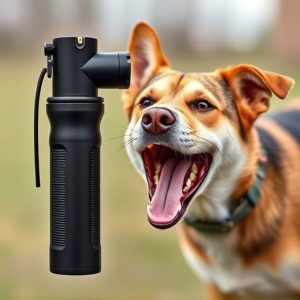Storing Pepper Spray Safely: Protecting Your Dog and Home
Storing pepper spray properly at home is crucial for responsible dog ownership and maintaining its e…….
Storing pepper spray properly at home is crucial for responsible dog ownership and maintaining its effectiveness. Keep it out of children's and pets' reach in a secure, locked cabinet or safe, in a cool, dry place away from direct sunlight or extreme temperatures. Regularly check expiration dates, practice handling, and maintain optimal performance by disposing of damaged or used spray responsibly. Ensure safety and peace of mind by selecting a low-temperature environment free from direct sunlight or high humidity, marking secure zones clearly, and familiarizing yourself with local laws.
“Enhance your dog’s protection with the power of pepper spray – a game-changer for safety in today’s world. This comprehensive guide explores how proper storage can make all the difference. From understanding its usage and safety features to choosing the ideal home storage location, we delve into creating an effective defense system.
Learn about responsible storing practices for pepper spray, ensuring it remains accessible yet secure. Discover tips for regular maintenance and expiration considerations to keep your pet and family safe.”
- Understanding Pepper Spray for Protective Dogs
- The Role of Storing Pepper Spray Safely
- Choosing the Right Location for Home Storage
- Creating a Comprehensive Safety Plan with Pepper Spray
- Regular Maintenance and Expiring Pepper Spray
Understanding Pepper Spray for Protective Dogs
Pepper spray is a powerful tool for protective dogs, designed to disable and deter potential threats without causing serious harm. When used correctly, it can provide an effective layer of protection for both the dog and its owner during outdoor activities or in emergency situations. Understanding how to use and store pepper spray properly is essential for responsible ownership.
Storing pepper spray at home requires careful consideration to ensure safety and accessibility. Keep it out of reach of children and pets, in a secure, locked cabinet or safe. Ideally, store it in a cool, dry place away from direct sunlight or extreme temperatures. Regularly check the expiration date and practice handling the spray to familiarize yourself with its operation, ensuring you can deploy it quickly and effectively when needed.
The Role of Storing Pepper Spray Safely
Storing pepper spray properly at home is an essential aspect of ensuring its effectiveness and safety. It’s crucial to keep it out of reach from children and untrained individuals, in a secure location that maintains consistent temperature and humidity levels. Avoid storing it near heat sources or direct sunlight, as extreme conditions can compromise the spray’s potency. A locked cabinet or high shelf is ideal for safeguarding the pepper spray.
Additionally, regularly check the expiration date to guarantee its freshness. Most pepper sprays have an average shelf life of 2-3 years, but this can vary based on brand and storage conditions. Always store it in its original packaging with labels intact for easy identification. In case of any damage or if the spray has been used, dispose of it responsibly and acquire a new one to maintain optimal performance when needed.
Choosing the Right Location for Home Storage
When storing pepper spray at home, selecting the appropriate location is paramount to ensure its effectiveness and accessibility. Keep it in a secure, low-temperature environment, away from direct sunlight or extreme heat sources. A cool, dry place like a locked cabinet or drawer in your bedroom or bathroom is ideal. This protects the spray from degradation and maintains its potency.
Avoid storing pepper spray in areas with high humidity as this can affect the product’s performance over time. Additionally, keep it out of reach of children and pets to prevent accidental usage or exposure. Remember, proper storage isn’t just about preserving the spray; it’s also about ensuring your safety and peace of mind.
Creating a Comprehensive Safety Plan with Pepper Spray
Creating a Comprehensive Safety Plan with Pepper Spray starts by understanding its proper usage and storage. It’s crucial to keep pepper spray within easy reach, but also secured in a safe location at home. Storing Pepper Spray Properly involves keeping it out of children’s grasp, away from direct sunlight or extreme temperatures, and locked up if possible. This ensures the spray remains effective for when you need it most.
In your safety plan, designate specific areas where pepper spray is kept, clearly mark these zones, and ensure all family members are aware of their locations. Regularly review and practice accessing these areas quickly to maintain preparedness. Additionally, familiarize yourself with local laws regarding pepper spray ownership and carry, ensuring you comply to avoid legal complications.
Regular Maintenance and Expiring Pepper Spray
Proper storage is key to maintaining the effectiveness and longevity of your pepper spray. When storing pepper spray at home, it’s crucial to keep it in a cool, dry place away from direct sunlight and heat sources. Extreme temperatures can degrade the active ingredients, reducing the spray’s potency. Ensure the area has minimal humidity to prevent any water damage or contamination that could impair its performance when needed.
Additionally, be mindful of expiration dates. Pepper spray typically has a shelf life of around 2-3 years, depending on the manufacturer’s recommendations. Regularly check the expiry date and dispose of expired pepper spray responsibly. Always keep it out of reach of children and pets to avoid accidental discharge or ingestion, which can be dangerous.
Jogging with your protective dog becomes an effective way to ensure both your safety and their well-being. By understanding how to properly store pepper spray for dogs, you enhance your preparedness in unexpected situations. Always keep it out of reach of children and pets, and regularly check the expiration date to guarantee its effectiveness. With proper storage and a comprehensive safety plan, you can leverage pepper spray as a valuable tool for your dog’s protection during outdoor activities like jogging.


